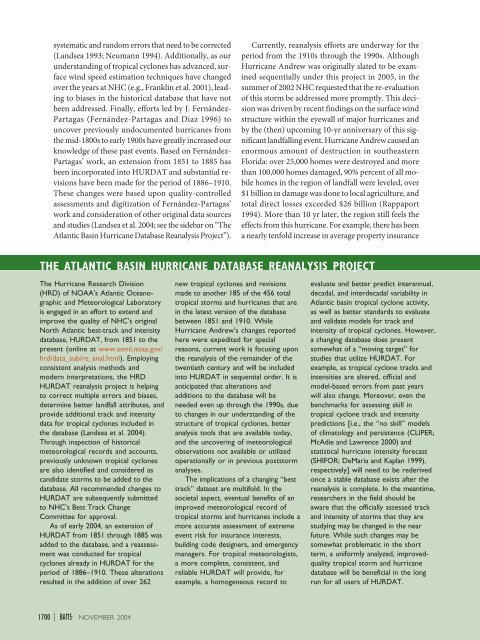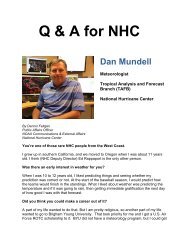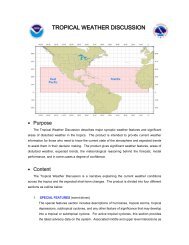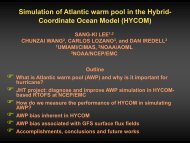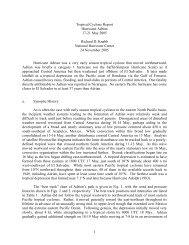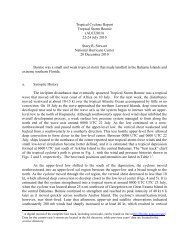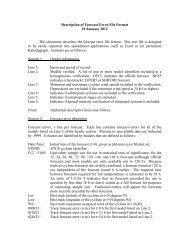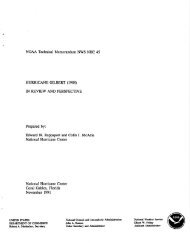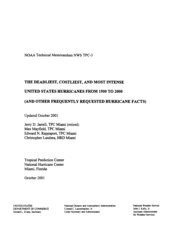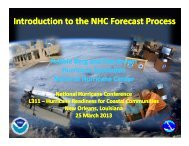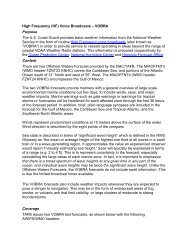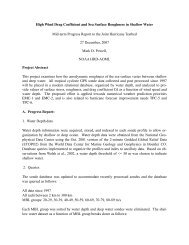A REANALYSIS OF HURRICANE ANDREW'S INTENSITY - National ...
A REANALYSIS OF HURRICANE ANDREW'S INTENSITY - National ...
A REANALYSIS OF HURRICANE ANDREW'S INTENSITY - National ...
Create successful ePaper yourself
Turn your PDF publications into a flip-book with our unique Google optimized e-Paper software.
systematic and random errors that need to be corrected<br />
(Landsea 1993; Neumann 1994). Additionally, as our<br />
understanding of tropical cyclones has advanced, surface<br />
wind speed estimation techniques have changed<br />
over the years at NHC (e.g., Franklin et al. 2001), leading<br />
to biases in the historical database that have not<br />
been addressed. Finally, efforts led by J. Fernández-<br />
Partagas (Fernández-Partagas and Diaz 1996) to<br />
uncover previously undocumented hurricanes from<br />
the mid-1800s to early 1900s have greatly increased our<br />
knowledge of these past events. Based on Fernández-<br />
Partagas’ work, an extension from 1851 to 1885 has<br />
been incorporated into HURDAT and substantial revisions<br />
have been made for the period of 1886–1910.<br />
These changes were based upon quality-controlled<br />
assessments and digitization of Fernández-Partagas’<br />
work and consideration of other original data sources<br />
and studies (Landsea et al. 2004; see the sidebar on “The<br />
Atlantic Basin Hurricane Database Reanalysis Project”).<br />
Currently, reanalysis efforts are underway for the<br />
period from the 1910s through the 1990s. Although<br />
Hurricane Andrew was originally slated to be examined<br />
sequentially under this project in 2005, in the<br />
summer of 2002 NHC requested that the re-evaluation<br />
of this storm be addressed more promptly. This decision<br />
was driven by recent findings on the surface wind<br />
structure within the eyewall of major hurricanes and<br />
by the (then) upcoming 10-yr anniversary of this significant<br />
landfalling event. Hurricane Andrew caused an<br />
enormous amount of destruction in southeastern<br />
Florida: over 25,000 homes were destroyed and more<br />
than 100,000 homes damaged, 90% percent of all mobile<br />
homes in the region of landfall were leveled, over<br />
$1 billion in damage was done to local agriculture, and<br />
total direct losses exceeded $26 billion (Rappaport<br />
1994). More than 10 yr later, the region still feels the<br />
effects from this hurricane. For example, there has been<br />
a nearly tenfold increase in average property insurance<br />
THE ATLANTIC BASIN <strong>HURRICANE</strong> DATABASE <strong>REANALYSIS</strong> PROJECT<br />
The Hurricane Research Division<br />
(HRD) of NOAA’s Atlantic Oceanographic<br />
and Meteorological Laboratory<br />
is engaged in an effort to extend and<br />
improve the quality of NHC’s original<br />
North Atlantic best-track and intensity<br />
database, HURDAT, from 1851 to the<br />
present (online at www.aoml.noaa.gov/<br />
hrd/data_sub/re_anal.html). Employing<br />
consistent analysis methods and<br />
modern interpretations, the HRD<br />
HURDAT reanalysis project is helping<br />
to correct multiple errors and biases,<br />
determine better landfall attributes, and<br />
provide additional track and intensity<br />
data for tropical cyclones included in<br />
the database (Landsea et al. 2004).<br />
Through inspection of historical<br />
meteorological records and accounts,<br />
previously unknown tropical cyclones<br />
are also identified and considered as<br />
candidate storms to be added to the<br />
database. All recommended changes to<br />
HURDAT are subsequently submitted<br />
to NHC’s Best Track Change<br />
Committee for approval.<br />
As of early 2004, an extension of<br />
HURDAT from 1851 through 1885 was<br />
added to the database, and a reassessment<br />
was conducted for tropical<br />
cyclones already in HURDAT for the<br />
period of 1886–1910. These alterations<br />
resulted in the addition of over 262<br />
new tropical cyclones and revisions<br />
made to another 185 of the 456 total<br />
tropical storms and hurricanes that are<br />
in the latest version of the database<br />
between 1851 and 1910. While<br />
Hurricane Andrew’s changes reported<br />
here were expedited for special<br />
reasons, current work is focusing upon<br />
the reanalysis of the remainder of the<br />
twentieth century and will be included<br />
into HURDAT in sequential order. It is<br />
anticipated that alterations and<br />
additions to the database will be<br />
needed even up through the 1990s, due<br />
to changes in our understanding of the<br />
structure of tropical cyclones, better<br />
analysis tools that are available today,<br />
and the uncovering of meteorological<br />
observations not available or utilized<br />
operationally or in previous poststorm<br />
analyses.<br />
The implications of a changing “best<br />
track” dataset are multifold. In the<br />
societal aspect, eventual benefits of an<br />
improved meteorological record of<br />
tropical storms and hurricanes include a<br />
more accurate assessment of extreme<br />
event risk for insurance interests,<br />
building code designers, and emergency<br />
managers. For tropical meteorologists,<br />
a more complete, consistent, and<br />
reliable HURDAT will provide, for<br />
example, a homogeneous record to<br />
evaluate and better predict interannual,<br />
decadal, and interdecadal variability in<br />
Atlantic basin tropical cyclone activity,<br />
as well as better standards to evaluate<br />
and validate models for track and<br />
intensity of tropical cyclones. However,<br />
a changing database does present<br />
somewhat of a “moving target” for<br />
studies that utilize HURDAT. For<br />
example, as tropical cyclone tracks and<br />
intensities are altered, official and<br />
model-based errors from past years<br />
will also change. Moreover, even the<br />
benchmarks for assessing skill in<br />
tropical cyclone track and intensity<br />
predictions [i.e., the “no skill” models<br />
of climatology and persistence (CLIPER;<br />
McAdie and Lawrence 2000) and<br />
statistical hurricane intensity forecast<br />
(SHIFOR; DeMaria and Kaplan 1999),<br />
respectively] will need to be rederived<br />
once a stable database exists after the<br />
reanalysis is complete. In the meantime,<br />
researchers in the field should be<br />
aware that the officially assessed track<br />
and intensity of storms that they are<br />
studying may be changed in the near<br />
future. While such changes may be<br />
somewhat problematic in the short<br />
term, a uniformly analyzed, improvedquality<br />
tropical storm and hurricane<br />
database will be beneficial in the long<br />
run for all users of HURDAT.<br />
1700 |<br />
NOVEMBER 2004


